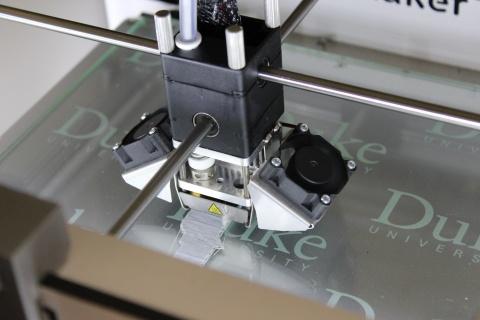
While printing a perfectly identical model of a human heart seems like the work of science fiction, this technology is being used every day across the world, including at Duke Hospital. 3D printing holds the potential to revolutionize medicine as we know it. Already, medicine has felt its impact in the past several years, with medical teams using 3D printing to bioprint blood vessels, create low-cost prosthetics, generate medical models, and construct implants. Currently, Duke Surgery is using 3D printing for cardiac, aortic, and facial skeleton prints to assist in surgery.
"The Duke University Hospital 3D printing lab is working to individualize patient care by printing patient-specific models to assist with surgical planning, enhance patient education, and reduce operative time.”
-Dr. Tawfiq Khoury, Resident in Otolaryngology
Duke University’s undergraduate campus hosts the 3D printing lab in their Innovation Studio. The lab is one of the largest open access printer farms in all of higher education, consisting of 33 3D printers. Three of those printers are known as FormLabs 1, which use stereolithography, a form of 3D printing that utilizes photopolymerization. These printers are used to create medical models due to their ability to create higher resolution prints, allowing for greater detail and accuracy.
How does 3D printing work?
3D printing, also known as additive manufacturing, works by taking a digital file, and then using the file to dictate the printer’s movement. It is known as “additive” manufacturing because the printer constructs objects by laying down successive layers of material. Once the layers have been added, the printing is finished and you have a 3D object at your disposal.
How is 3D printing used in medicine?
To print a medical model, doctors acquire a CT scan from a patient, and use that two-dimensional imaging to create a digital file for the 3D printers. MRI’s and ultrasound have also been used; however, CT scanning is the most popular technique. This process allows doctors to create customized, patient-specific implants, prosthetics, and models. Patients also benefit from 3D printing because they can get a better understanding of their body and the surgical procedure they will undergo.
As Duke surgical resident Dr. Tawfiq Khoury explains, "The Duke University Hospital 3D printing lab is working to individualize patient care by printing patient-specific models to assist with surgical planning, enhance patient education, and reduce operative time. 3D printing offers us a huge opportunity for research in various disciplines as well as an avenue to create models in order to help train future surgeons.”
What’s the future of 3D printing in medicine?
The future of 3D printing in the realm of medicine is exciting. Researchers are exploring the potential for bioprinting organs, skin, and bones. Already, companies like Organovo have found ways to bioprint liver cells that can live up to 40 days.
“Eventually I see the 3D printing of prosthetics vital to surgeons in various disciplines, and we plan to pioneer some of that work as we grow," says Khoury who has adopted 3D printing into his own surgical practice. Khoury, along with other surgeons, is working closely with engineering colleagues to develop new instruments that may be useful in the operating room.
3D printing will continue to progress and evolve over time, and Duke Surgery is excited to be at the forefront of this developing, cutting-edge technology.